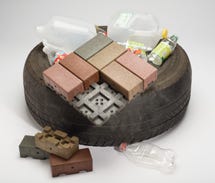Clean Tech competition pits new monomers against composite bricks
Two new monomer platforms and a composite masonry ultimately vied to be the winner of the Clean Technology Business Forum & Competition, after six companies presented their business plans to a seven-person panel at the Society of Plastics Engineers (SPE) Global Plastics Environmental Conference (GPEC; March 8-10; Orlando).
March 15, 2010
Two new monomer platforms and a composite masonry ultimately vied to be the winner of the Clean Technology Business Forum & Competition, after six companies presented their business plans to a seven-person panel at the Society of Plastics Engineers (SPE) Global Plastics Environmental Conference (GPEC; March 8-10; Orlando). Ultimately the winner of the fourth-annual Clean Tech award was Amsterdam-based Avantium, whose CEO, Tom van Aken, laid out a path to biopolymers and biofuels based on converting carbohydrates into furanic chemical building blocks. Already covered by 15 patents, the technology could be used to create a biobased route to polyesters, polyamides, and polyurethane, with the technology applying polycondensation for polymerization that could allow it to run on retrofitted reactors.
Taking home second prize in the Clean Tech competition, as well as the SPE Environmental Division: Design for Sustainability award, was VAST Enterprises LLC (Minneapolis, MN). VAST CEO Andy Vander Woude pitched his injection molded product, which consists of post-consumer rubber and plastics plus "secret sauce" combined into composite masonry. Molded into pavers and other products, the product is pitched as an alternative to molded concrete or clay bricks. Launched in 2007, the bricks, which are supplied with a molded sub-structure to ease installation and alignment, are made from 95% recycled materials, and compared to the concrete they're aiming to replace, use 82% less energy and 89% less carbon dioxide in their manufacture. Available in different colors, Vander Woude says the company supplies the bricks with a 10-year warranty, but offers a lifetime warranty against cracking and expects a product life of 25-30 years.
Cora Liebig, director of R&D at Segetis (Golden Valley, MN), offered up another new monomer; this one a cellulosic-biomass derived molecule that could be applied in polyols, plasticizers, and solvents. Founded in 2006 and already protected by nine patents, Segetis has already opened a semiworks plant for its levulinic acid, with capacity of 250,000 lb/yr. The company's product starts as corn cobs in China that are converted to furfural, and eventually, levulinic acid. At this time, Liebig believed solvents represent the largest potential market, worth around $40 billion, but the company also sees opportunities for biobased polyols, which she felt were competitive with soy-based polyols that have entered the market, as well as levulinic acid-based plasticizers, which Liebig said, "drastically improve migration,"—a concern that has dogged market-leading phthalates.
|
VAST injection molds a compound consisting of post-consumer tire rubber and plastics into composite bricks, like these pavers. |
The top two teams received cash prizes, sponsored this year by Batelle. Eric Koester, who acts as the program coordinator and moderator and is an attorney with Cooley Godward Kronish LLP, said the six finalists came from 20 entrants. Other finalists included AmbientEco Group, which presented a system for sorting municipal waste into fuel predecessors; Fiberforge, which presented on its automated system to speed production of advanced thermoplastic composites; and Soy Works, which highlighted biobased plastics derived from different plant proteins. —Tony Deligio
About the Author(s)
You May Also Like



